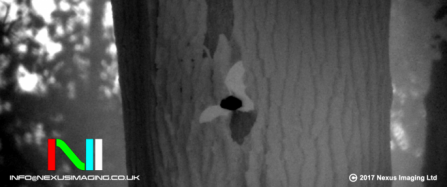
Barbastelle Roost (c) Russell Savory & Nexus Imaging Ltd

Barbastelle Roost (c) Russell Savory & Nexus Imaging Ltd
Development is one of the most significant pressures facing wildlife in Hertfordshire and Middlesex. The Trust regularly reviews and submits comments to local authorities when planning applications come forward which may have significant impacts on wildlife.
In December 2015 Matt Dodds, the Trust’s Planning and Biodiversity Manager, reviewed a planning application for the A120 bypass at Little Hadham in east Hertfordshire. Matt’s review of the application showed that it did not take proper consideration of the impact on barbastelle bats. Barbastelles are one of the Trust’s priority species and an important population had been identified by the Herts and Middlesex Bat Group in nearby woodland, close to the application site.
Following objections from the Trust and the Bat Group, planning was delayed by Hertfordshire County Council to allow recommended surveys to be carried out by ecological consultants. During these surveys, several barbastelles were radio tagged and the data was used to observe how the bats interacted with the existing road to help analyse potential impacts of the proposed scheme and resulted in the inclusion of additional mitigation measures such as habitat creation, light impact reduction, the creation of an underpass, and ongoing monitoring of the barbastelle bat population.
Barbastelle bats – a priority for the Trust
The existing evidence of barbastelle bats near to the proposed bypass meant the scheme would be changed. However, the Trust and the Bat Group realised that there was a wider lack of records for barbastelles across much of the rest of the county. Without evidence, barbastelle populations could be threatened by future proposed developments. With barbastelle bats classified as a European Protected Species (Annex II) under the Conservation of Habitats and Species Regulations 2010, Near Threatened on the IUCN Red List, protected in the UK under the Wildlife and Countryside Act, 1981, and classified as a Priority Species in the UK Biodiversity Action Plan, the Trust is committed to their conservation and has identified barbastelles as one of seven priority species in the 2016-2021 Strategic Plan.
Mapping barbastelles
The Barbastelle Bat Project has been set up in partnership with the Herts and Middlesex Bat Group and aims to increase our knowledge of the bats’ distribution in the county. In summer 2016, the Trust trained bat surveyors in barbastelle detection and carried out a series of surveys at Tarmac’s Panshanger Park which recorded some barbastelle activity, although not a maternity colony.
During spring 2017 eight static detectors were deployed in nearby woodlands in an attempt to pick up barbastelle activity and build a robust database of records. The surveys started positively with 60 new records generated before the middle of May. One exciting new find was at our Balls Wood Nature Reserve where three barbastelle contacts were made – a new record for the area.
Over the summer the Project continued, with more concentrated efforts being guided by the earlier surveys. To date the project has generated 228 records and by concentrating on sites of high potential it is hoped that maternity colonies will be identified. If maternity colonies are found, the project aims to catch and radio tag individuals in order to find their maternity trees, foraging areas and commuting routes. Once the maternity trees have been located we can count how many bats are in the colony, mark the individuals with rings to facilitate population monitoring, and protect the trees themselves. All records gained will give a better insight into local barbastelle distribution, helping to conserve this rare species and mitigate against future risks.
The Trust would like to thank the John Spedan Lewis Foundation, Spear Charitable Trust and Christopher Laing Foundation for their generous donations towards the cost of purchasing bat detectors and other equipment for the Barbastelle Project, along with all the volunteers who are supporting the Project.
In September, the BBC Inside Out team visited the site together with all the contributors to the Barbastelle Project. Nexus Imaging Ltd and Russell Savory filmed the bats using a thermal imaging camera to detect Barbastelle roosts and capture emergence of the bats.